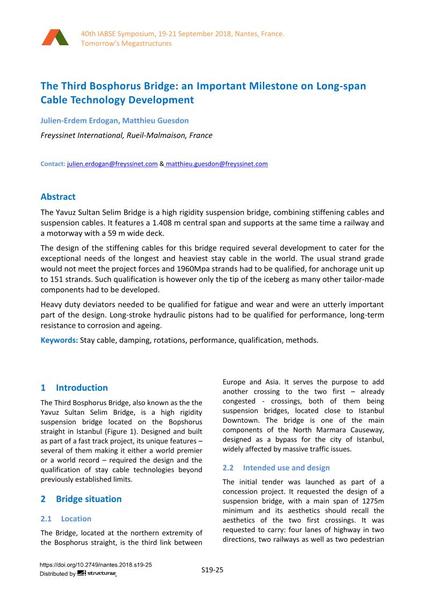The Third Bosphorus Bridge: an Important Milestone on Long-span Cable Technology Development

|
|
|||||||||||
Bibliografische Angaben
| Autor(en): |
Julien-Erdem Erdogan
(Freyssinet International, Rueil-Malmaison, France)
Matthieu Guesdon (Freyssinet International, Rueil-Malmaison, France) |
||||
|---|---|---|---|---|---|
| Medium: | Tagungsbeitrag | ||||
| Sprache(n): | Englisch | ||||
| Tagung: | IABSE Symposium: Tomorrow’s Megastructures, Nantes, France, 19-21 September 2018 | ||||
| Veröffentlicht in: | IABSE Symposium Nantes 2018 | ||||
|
|||||
| Seite(n): | S19-25 | ||||
| Anzahl der Seiten (im PDF): | 8 | ||||
| DOI: | 10.2749/nantes.2018.s19-25 | ||||
| Abstrakt: |
The Yavuz Sultan Selim Bridge is a high rigidity suspension bridge, combining stiffening cables and suspension cables. It features a 1.408 m central span and supports at the same time a railway and a motorway with a 59 m wide deck. The design of the stiffening cables for this bridge required several development to cater for the exceptional needs of the longest and heaviest stay cable in the world. The usual strand grade would not meet the project forces and 1960Mpa strands had to be qualified, for anchorage unit up to 151 strands. Such qualification is however only the tip of the iceberg as many other tailor-made components had to be developed. Heavy duty deviators needed to be qualified for fatigue and wear and were an utterly important part of the design. Long-stroke hydraulic pistons had to be qualified for performance, long-term resistance to corrosion and ageing. |
||||
| Stichwörter: |
Schrägkabel Methoden Dämpfung
|
||||
